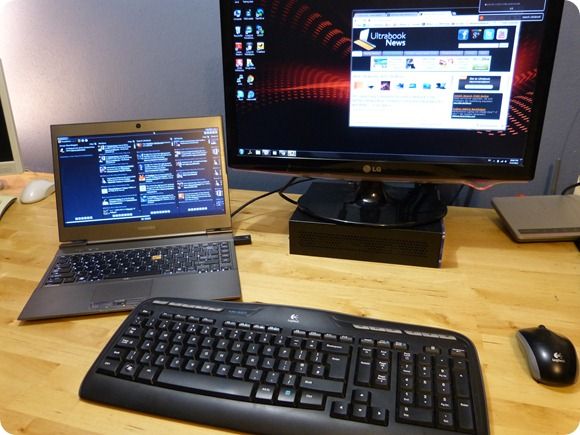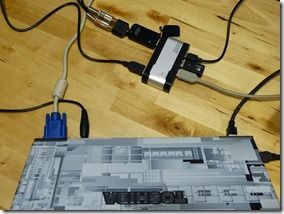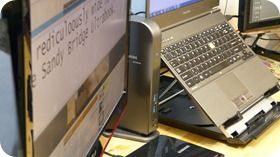Thinking of upgrading a desktop PC? Upgrading a Netbook. A 10″ Tablet? Now that Ivy Bridge 2nd-Generation Ultrabooks are here and we’re heading into a period of marketing and competition it’s the perfect time to consider converging to an Ultrabook.

A few weeks ago I turned off my desktop PC. It’s the first time it’s been shut down and disconnected for the 3.5 years that I’ve had it. In it’s place is nothing, until I plug my Ultrabook in. The reason I’m doing this is simple; The Ultrabook is better than the desktop for all but a few use cases.
My Ultrabook is now my sofa PC, my home office PC, my office PC and in most cases I’m preferring the Ultrabook to the 10” tablets (Windows and Android) I’ve got here. It hasn’t replaced a 7″ tablet that follows me everywhere for laid-back Internet usage but it gets close as I tend to lift the lid on the Ultrabook if I need to type anything more than a few lines.
I’ll walk through some of the methods, problems and possibilities later in the article but first, lets think about why you might buy an Ultrabook to replace a desktop and a 10” tablet, an older notebook and a netbook.
Let’s assume you have a 3 year old desktop and a 2 year old laptop, possibly a netbook too. A total upgrade of that lot is going to cost well over $1000. By moving to an always-available, SSD-based laptop like an Ultrabook you get an impressive package of advantages for much the same cost as an upgrade.
- One computer instead of 3 (home office, mobile laptop, work office) saves money on hardware, OS licensing, software.
- Faster SSD-based or SSD-supported storage to replace a slow hard drive – a major advantage.
- Quick availability due to fast resume times – an experience that is more significant that it sounds.
- Move desktop storage to a 24/7 NAS with cloud sync, RAID, printer support and DLNA for in-house and online sharing. Safer, more security, more availability, higher capacity.
- Less need to sync docs via cloud over multiple PCs – Syncing over multiple clients and with multiple services often introduces risks of incorrect or failed synchronization.
- Save energy
- Use 2 screens instead of one on a desktop without buying an additional desktop screen. Some recent Ultrabooks support three concurrent screens. Docking stations can increases to four screens.
- Quieter, often silent, operation
- Security advantages of having one device to update and manage. More devices = less security. (Note: Security is not the same as availability.)
- Upgrade from USB 2.0 to USB 3.0 which is now implemented on all Ultrabooks using the 3rd-gen Core CPU
- Consider upgrade from SDHC from SDXC
- Latest HDMI capability (upgrade from VGA/DVI)
- Consider upgrade to 3G-capable Ultrabook
- Potential for Wireless Display to TV in sofa scenarios or at desk.
- Option to upgrade home Wi-FI to latest 5GHz solution
- Use old laptop as fall-back solution
- Low-cost Windows 8 upgrade path when a new Windows 7 Ultrabook is bought now before end of 2012
- Future: Touch, thunderbolt, Windows 8
- Feel-good factor of buying and owning a slim and light Ultrabook
Why Ultrabook?
There is one major advantage to an Ultrabook over a laptop – you can always rely on an Ultrabook to be tuned for faster availability. That means fast resume times, longer standby availability and faster access to files. At this point we have to recommend a full SSD-based Ultrabook for the best availability. Some hybrid solutions are good. Some aren’t, and it’s difficult to tell which are good and which aren’t without reading through reviews.
Our top tip for any upgrade, even outside the Ultrabook range, is to invest in an SSD-based solution.
Ultrabooks are also offering key features that make laptop computing more productive. For example they generally (not always) offer high quality wireless solutions which is an important part of mobile and office computing. Dual-antenna dual-channel solutions for example can run up to 300Mbps theoretical speed. Back-lit keyboards, Wireless Display, array microphones and wide viewing angle displays are other examples of optional features on Ultrabooks. You’ll find some of those productive options in the budget laptop class too but do make sure you get a desktop-class processor and that SSD. We recommend a Core i5 or i7 (the Core i3 CPUs are not able to provide short-term Turbo Boost) and an SSD that has a good read and write speed at smaller block sizes.
Ultrabooks also offer the slim, light and stylish design that will make the laptoping experience far more enjoyable. The latest Ultrabooks also offer the HD4000 GPU for good quality 3D graphics support, Open CL support, more efficient media playback support and three concurrent screens. If you’re choosing a solution for the next two or more years, it makes sense to look at the new generation of Ivy Bridge based devices with the Intel HD 4000 graphics.
AMD Trinity-based systems are starting to filter in slowly so keep an eye out for systems based on this platform. E.g. HP ENVY Sleekbook 6z-1000 (Aff.)

Cable Salad
I confess; One of the annoying things about using a laptop as a desktop is the desktop set-up time. Power, monitor, USB hub and, in my case, a Gigabyte Ethernet port all need to be plugged in before use. If I’ve left the power adaptor somewhere else I’m in trouble too. One of the most important things to think about is keeping things tidy and consolidating the cables. In the image to the right you see I’ve added a cheap USB sound module so that I don’t have to plug/unplug the audio cables. A USB-based external keyboard mouse can be left connected and there’s the possibility of an Ethernet port too. A good quality powered USB3.0 port is worth investing in.
After plugging in the USB ports, you’re left with the monitor and power and even the monitor connector can be brought to the USB port. Check out USB3.0 –> HDMI solutions based on DisplayLink 3900 display extender. We wouldn’t recommend the older USB2.0 solutions for productive work on external displays.
This review of a Targus USB 3.0 HDMI adaptor is worth reading. It uses, like many of the docking stations, DisplayLink technology which appears to have matured well in its USB 3.0 version.
For the ultimate in cable management, look into a USB or Thunderbolt-based docking station. See below.
USB 3.0 Docking Hubs
An alternative to the simple USB hub with multiple adaptors is a purpose-built USB docking hub.
Top tip: Buy a USB3.0 docking station, not a USB2.0 docking station.
The Toshiba Dynadock U3 is a USB3.0 docking station and includes a built-in 5.1 sound module, Gigabut Ethernet port and multiple USB hub ports but you’ll find two display ports (HDMI + DVI) that can be used concurrently. Our video review is already available (see video below.) Text review available soon.
Lenovo and Targus have similar USB3.0 docking solutions.

We’re reviewing the Toshiba Dynadock right now and will bring you a full review soon.
A note on USB connectivity. USB-based adaptors may bypass some local Ethernet, audio and video enhancements and features and all devices require drivers to be loaded which, naturally, increases the amount of software on an Ultrabook and can reduce stability and efficiency. We have not had any issues in our multi-week USB hub test or with the Dynadock
Network Attached Storage (NAS)
We didn’t mention USB-based storage above because for a productive environment we don’t think it’s the right solution. Use a USB drive to archive or add local portable storage but don’t relay on it as a main drive. That’s where the network-attached solutions come in.
Getting cheaper by the day are high capacity resilient network storage systems. In basic terms they comprise a hard drive (or drives) in a basic chassis running a Linux OS with network adaptor(s.) I have personally been using a Buffalo Linkstation Duo 2TB drive with Gigabit Ethernet connection. It provides Windows-based (SMB) access, FTP access, NFS (Network File System) access, a DLNA server (the drive media contents can be viewed or played on other DLNA devices on the same network) a mirror function (where two Linkstation devices on the same LAN back each other up) and a BitTorrent client. The 2TB drives are configured as a mirrored (RAID 1) 1TB system. In general the setup works perfectly at home as a media and document storage device but I would recommend that you always connect via a wired Gigabit LAN for productivity work. Wireless LAN connections can be tricky to use where large folder and libraries are concerned. Expect to pay over $200 for a 1TB mirrored (RAID 1) system.
Cloud Storage
A combination of cloud storage and synchronization to a NAS can be a real advantage. While many NAS systems allow you to access files from the Internet it’s neither the fastest solution or the most secure solution for your network.
By combining home storage with cloud syncronisation to the cloud you can be sure that your most important files are available wherever you go, regardless of whether they are on your Ultrabook. The topic of cloud storage, the options, costs and risks involved is not something we’ll cover in the article but we will point out there there are NAS systems that can sync to cloud services.
Checklist and Price
When making the upgrade to a converged Ultrabook solution, consider the following.
- Ultrabook (100% SSD storage, USB3.0, HDMI minimum)
- Powered USB3.0 Hub
- Second mains charger
- USB-Based sound module (E.g. I use a Soundblaster X-Fi Go and leave my mixer attached) USB keyboard and mouse (The latest wireless models last for many months on a single set of batteries)
- USB 3.0 docking hub
- Protective Case for Ultrabook
- Optional – USB or Network storage
- Optional USB Gigabit Ethernet adaptor
- Quality wireless mouse and keyboard with long battery life

Other things to think about
External cooling laptop stand to help Turbo (and a ‘docked’ Turbo profile) I’m currently using the basic model on the right but there are models with silent cooling fans and USB hubs.
Security to increase privacy and file security. Keep those passwords in a password safe. Think about hard disk encryption. Consider services enabled with Intel Identity Protection Technology and make sure files are regularly backed up (and regularly archived if you need a timeline.) Let Windows run Defender and create restore points. Use Windows 7 Backup and Restore to take an image of your system and to create restore hard disks.
Other:
- USB DVD Writer (See our recent article)
- Thunderbolt-based PCI-E graphics cards
Future
There are a lot of technologies evolving in the area of wireless connectivity that might be interesting and could develop well in the future. Thunderbolt is a technology that could enable higher-quality docking. Thunderbolt docking solutions are currently expensive and Ultrabooks with Thunderbolt ports rare.
Wireless display via Wi-Di appears to be developing. LG, Samsung and Toshiba all have Wi-Di enabled TVs and Samsung even have a Wi-Di enabled desktop monitor. We haven’t tested Wi-Di for desktop use yet.
End of the Desktop?
The desktop sill has a place in some working scenarios. In many cases it’s a more secure option for companies where workers do not have to be mobile and continues to be a solution that has a longer life than a laptop due to upgrade possibilities. There are other scenarios where a desktop might be a better solution than an Ultrabook.
- Fast, local, RAID-enabled, high capacity storage. E.g. professional video production
- Multiple printer, scanners. Many of these peripherals are available as wireless devices now but there may be situations where this is not desired.
- Hosting services for other PCs or users.
- PCI card hosting
- Gaming and other GPU-intensive tasks
- Video, image, audio production
- CAD
- Dedicated PCs (low power, measurement and control systems, home theatre)
- Modding, overclocking and upgrade
- 5-year+ service requirements
- High-end CPU requirements for scientific applications, file compression, CPU-based rendering, bulk image editing,
- CPU-intensive silent solutions (that might require water cooling for example)
Summary
The Ultrabook can function as a desktop for most, if not all, daily PC-based tasks. The responsive designs, especially where a pure SSD-solution is used, can improve productivity over a PC. Convergence brings multiple advantages and moving to an ultra-portable system provides more freedom to work in new situations.
What Ultrabook?
Take a look at our reference article – the Ultrabook Buyers Guide. We’ve got all the Ultrabooks listed in our database and we’re sure you’ll easily find a solution through our addition buyers tools. Ultrabook Buyers Guide.
Your Solution
Tell us about your experience and method for using an Ultrabook as a desktop. What’s the biggest issue you’ve had?











Why don’t you just replace all of that & go buy an iPad instead? According to all the Apple-leaning tech blogs pretty soon that’s all everyone will need.
I can hardly wait until 1 day when I walk into my office floor & everybody in their cubicles will be thumb-typing/talking to their iPad’s instead of using PC’s.
since iPad’s are close to useless for a lot of work.
All the bloggers on said tech blogs that talk about laptops dying all use laptops (mainly MBA’s, with the occasional MBP, I know at least one blogger uses an X220 as well) themselves. Try typing more than 5 words on a tablet. An email is an exercise in frustration, programming/etc are pretty much impossible with a touch screen keyboard.
Pretty sure that was actually dry humor!!! Replace all of that & buy an iPad? Everybody thumb-typing & talking to their iPads?
Why do all Ultrabooks only have those shitty micro hdmi and even vga?!
I want to use my big 30″ screen and there is just no way to connect it and use the native resolution with the current ultrabooks.
Only Apple has Thunderbolt but I don’t want Apple.
Acer Aspire S5 have Thunderbolt.
There are lots of Ultrabooks with full HDMI. The Acer S5 has Thunderbolt.
https://www.google.com/search?q=%22physical+interfaces%22+hdmi+site%3Aultrabooknews.com%2Fdatabase Is a good starting point for devices with HDMI
It’s not a matter of micro HDMI vs full HDMI. The problem is that HDMI doesn’t drive a screen larger than 1920×1200. Most 27″ and 30″ screens are 2560×1440 requiring Thunderbolt or DisplayPort. (Theoriests will say that HDMI v1.4 can drive the larger monitors, but in practice there are no HDMI/monitor combinations that exceed the single-link DVI compatibility limitation.)
Good solution Chippy. I’m planing exactly that with my Samsung Series 9, when the uni starts again :) 22″ monitor, hub, 4 GB external drive, mouse and keyboard :)
What’s that stand you got for the toshiba ultrabook?
It’s a basic stand from ultimate-addons in the UK but I can’t find it in their catalogue now. There’s an image of a Kensington basic holder in the article. I use that at another desk I have. click on that to go to the Amazon page. There are lots of them around.
I have this cool stand called Griffin Elevator
check it out:
http://store.griffintechnology.com/elevator
Won’t be doing that kind of downgrade anytime soon. My old PC with dual GPUs runs laps around any ultrabook.
Just not an option for power users that being said, writters and people who surf the web and update office docuemnts can live with that kind of low power solution. I cant see that option being popular in my circle since you have to pay double the price of a PC for an ultrabook that cant even compete power wise.
I’ll keep hugging my 30″ HP Z30W and caressing my dual GTX580s.
What do you do that would make an ultrabook inadequate? Games?
Games? at 39 years of age I have better things to do than play games. If you think, processing power has no importance, they should stop making new models every year and you can buy a laptop from 5 years ago and be happy.
Anyways, I doubt you have security clearance required to get more details about my occupation.
@StanB
You seemed to have emphasized the dual GPUs of your PC so that’s probably where that assumption came from.
So you wouldn’t just go with a notebook at home either? Does your home computing require dual GPUs too
You are right, but that is too big for me. I just want the smallest and lightest notebook so i can allways take it with me. So best would be 11″ and 13″ is absolute max.
I use a Thinkpad X230 with a dock. Though I still use an Intel Xeon based Dell Precision workstation for tasks even the standard voltage mobile CPU in the X230 can’t handle fast enough.
Sorry, but this looks like an ugly and chaotic solution for the desktop. Lots of cables and additional devices. WAF = 0.
I would prefer an All-in-One PC like the iMac on my desk and leave the Ultrabook/Macbook to the road.
No denying that some people like convenience!
Having said that, this is a solution that’s mobile.
Any chance the USB 3.0 dock can output to a 2560×1440/1600 monitor? Main want missing on my UX31E is a Displayport out.
Hasn’t there been a trend of people replacing their desktops with notebooks for a few years now? At least in the consumer markert. I only see desktops being mostly used by professionals who require as much performance as possible or gamers.
You really made me think about replacing my 4,5 yrs old desktop with a new Sony Vaio Z..
This would also be the solution for my Zenbook Bleeding issue.. :-X